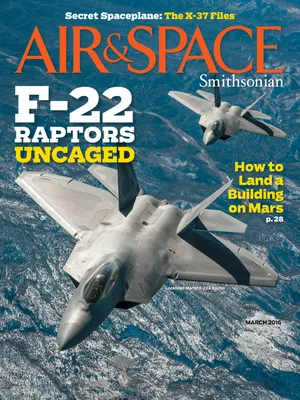Crash Correspondent
TV reporter Tom Costello recounts what he’s seen and learned in a decade of covering commercial aviation accidents.
/https://tf-cmsv2-smithsonianmag-media.s3.amazonaws.com/filer/7c/c3/7cc3f934-f351-4bd5-81e9-476b852cef3c/tomcostello.jpg)
A Washington, D.C.-based correspondent for NBC News, Tom Costello has been reporting on airplane crashes for 10 years. Senior Associate Editor Diane Tedeschi spoke with him in October.
Air & Space: After a major airline disaster, how quickly do you begin your reporting?
Costello: I’ve got several beats that I’m responsible for at NBC News, but when there’s an aviation incident, that immediately takes priority. I will very often jump in front of a camera, and my producer, Jay Blackman, will begin working the phones behind me.
How close is the press allowed to get to a crash site?
Well, we obviously respect all law enforcement and EMS [emergency medical services] tape. So we’re not going to cross any lines whatsoever. Generally, they will keep us pretty far away. For example, with the Asiana crash [in San Francisco in 2013], that was an active runway. We’re not going to come anywhere near an active runway. In that case, we were actually quite far away—I think at a hotel parking lot.
Do you find that those in the aviation industry are reasonably accessible to the press?
My experience is that when there’s an incident or an accident, any party to the investigation is going to be very cautious and not want to say much. So whether that’s the Air Line Pilots Association or the National Air Traffic Controllers Association or the airline itself, early in the investigation they generally are not going to weigh in much as to what may or may not have contributed to a crash. And that is why we rely on the expertise of people who’ve spent years or decades in that field, and will give us an objective analysis of the facts as we know them. I avoid getting into the realm of conjecture—that’s not my job.
Has it been your experience that someone who has retired from the industry might be more forthcoming as a source?
It really depends on the individual. The people we’ve come to rely on are people who are retired, but they still very much have their ear to the ground and have a good sense of what’s happening in the industry. And we feel that they can be of value to the public by explaining and educating. When we interview somebody in the middle of a major story, I am not looking for an expert who’s going to say something dramatic and then the story takes on a life of its own. I’m looking for factual and precise information that is of value to the audience.
In reviewing some of the stories you’ve covered, I see that many of them involved human error.
And it’s almost always a series of things that goes wrong. It’s rarely just one thing. I’ve talked to engineers at both Boeing and Airbus, and they both say the same thing: The planes that are designed and built today have so many layers of redundancy that it requires many things to go wrong for the plane to crash—and usually that involves human failure.
I’m struck by how frequently flight crews engage in small talk and non-essential activities during takeoff and landing.
I know that this is a constant concern for the FAA and the NTSB [Federal Aviation Administration and National Transportation Safety Board]. Human nature tends to get complacent. You do a job over and over every single day, and perhaps you let your guard down. But as we saw in the case of the Miracle on the Hudson, if you listen to those cockpit recordings, Captain Sullenberger and his copilot, Jeff Skiles, they were all business from the moment they were in that cockpit.
What makes the U.S. aviation industry one of the safest in the world?
I think there is a complete obsession with safety in this country [and a] system-wide focus on safety at every level, from the tarmac to the cockpit to the air traffic control tower to the boardrooms of the airlines. They all get it. There is also an obsession with data. There’s now a self-reporting mechanism in place for pilots and air traffic controllers to report when they have had a close call. All of that data is fed into the system so that analysts can look for patterns to be aware of—whether it’s problems involving air traffic control at a particular airport or whether it’s some switch that’s confusing pilots in the cockpit. When all of that data is fed in regularly and made available to airlines and federal regulators, they can identify potential problems before they become a problem, and that’s been a huge benefit to improving safety in the country.
Has your reporting ever made you hesitant about flying?
No. In fact, reporting on aviation for the last 10 years has made me more convinced than ever that this is by far the safest way to travel. It’s safer to travel in an airplane than it is to drive to the airport. I’ve been standing here at [Ronald Reagan Washington National] airport today doing live shots for the “Today” show on the computer glitch affecting the Southwest Airlines reservations system. And I’m watching these planes land and take off—the carefully coordinated ballet between the air traffic controllers and the planes—and I marvel at what a safe system we have.
